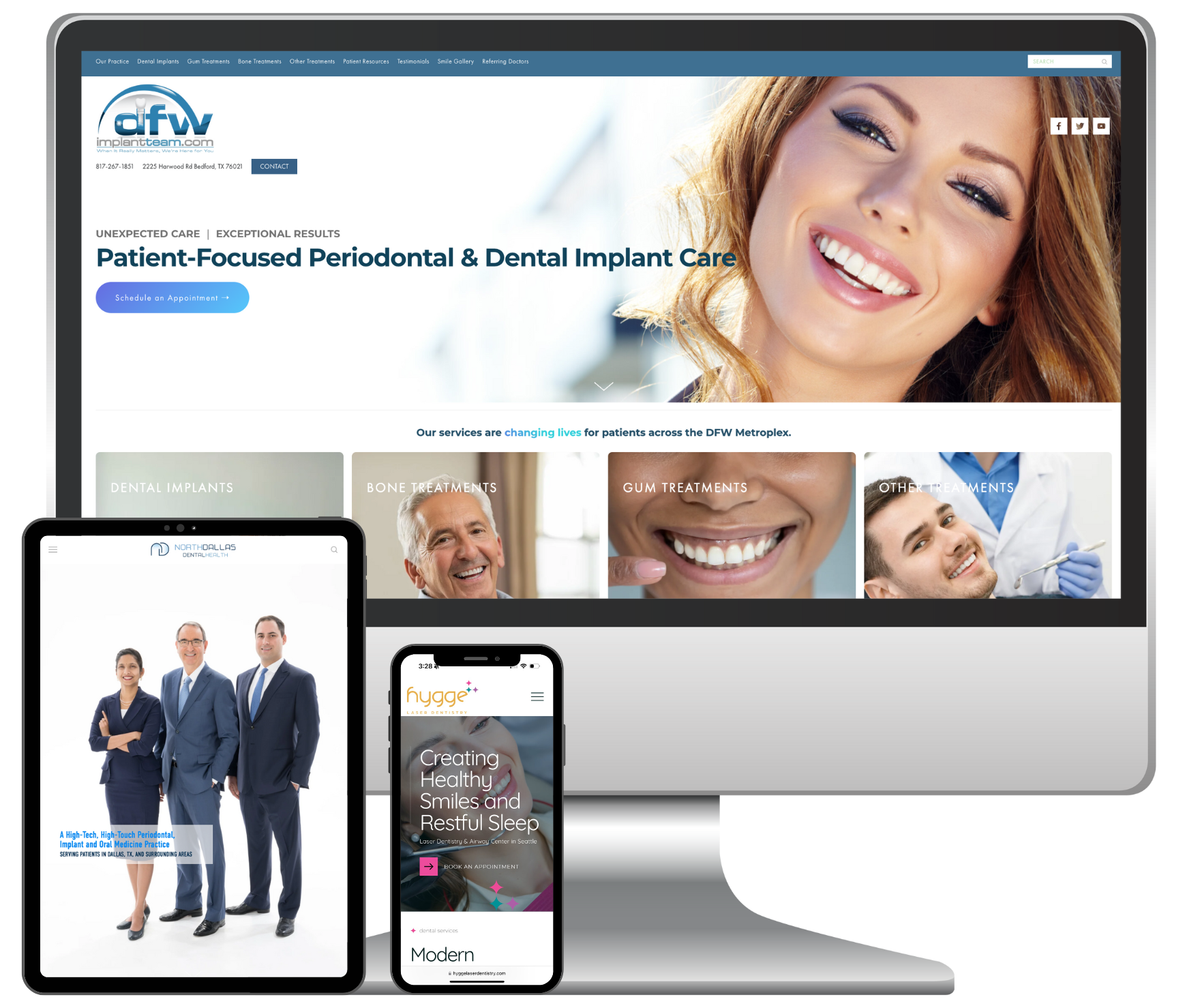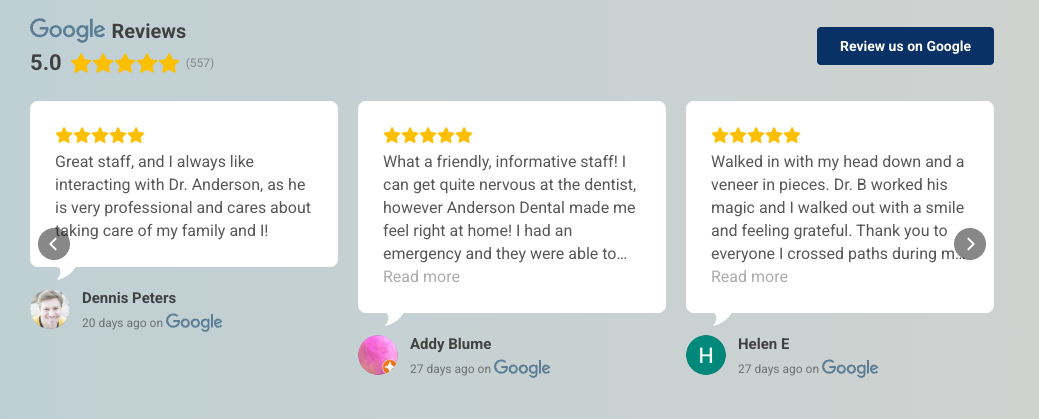5 Key Elements to Enhance Your Dental Website
Looking to improve your dental practice's website? Wondering if investing more time or money into your dental website is even worth it? At this point in the digital age, it shouldn't take much convincing that your practice website can make or break your marketing efforts. If your own personal experience encountering both good and bad websites isn't enough to convince you, here are some statistics that might.
STATISTICS ABOUT WEB DESIGN
- 94% of consumers say a website must be easy to navigate
- 38% of people report they would navigate away from a badly designed website
- 40% of people will leave a slow-loading website
- 39% of users make a judgment about a business based on the quality of the website
So how is your dental website? Have you looked at it lately? What about on mobile? Go ahead. We'll wait...
What did you think? Do you love it? Is your site easy to find and navigate? Engaging and relevant? Regardless of where your website falls on the scale of poor to excellent, consider the importance of a great dental website and then begin strategically implementing these five key elements that every good website needs to stand out in the modern marketplace.

The Importance of a Great Dental Website
Yes, the statistics prove true. Your website matters. But why? Ultimately, a website is the primary point of preliminary conversion for potential and existing patients. The patient journey typically follows the same pattern:
- Exposure - Exposure may come through an internet search or an organic referral. Either way, exposure to or awareness of your dental practice simply peaks the interest of a potential patient and inspires further consideration and research.
- Consideration - During the consideration phase, a potential patient typically follows a 3-step process. Visit the website. Read online reviews. Check out social media.
- Trust - The trust (or preliminary) conversion occurs when a potential patient books an appointment with your office.
- Conversion - Actual conversion happens when a patient follows through with an appointment and either accepts a treatment plan or invests in a loyal patient-practice relationship.
But there's more...you shouldn't be content to stop at conversion! The final step in the patient journey is practice advocacy. Forward-thinking dental practices understand that a good dental website combined with a positive dental experience creates an easily accessible opportunity for patients to organically advocate for your practice in real life and in the digital world. Having a high quality dental website means patients can easily share and recommend your practice at the drop of the hat.
So how do you improve your dental website? Here's five key elements to building out a professional, conversion-driven dental website.
Five Key Elements To Enhance Your Dental Website
1. Professional photography and videography
Professional photography and videography helps set your dental website apart. In a sea of stock photos, be distinctively personal. Patients want to see the people who will be providing their care and the environment they will experience. While dental care may seem quite routine to dental professionals, choosing a dental provider can be anxiety-inducing and highly personal for patients. Footage and pictures of your staff, your office, and even patient testimonials help to ease fears and build trust among potential patients for higher conversion rates.
2. Patient education resources
Patient education resources add so much value to a dental website and are relevant for every dental specialty. Resources might include:
- a dental blog
- glossary of terms
- smile galleries
- educational videos
In the marketing world, we call this "content marketing", which simply means publishing valuable, relevant and shareable content for your target audience. People regularly research health conditions, treatments, alternative care options and local resources in search engines and AI programs. Providing educational resources to answer questions, establish authority and increase visibility drives new traffic to your website and increases search rankings across all platforms. Providing relevant content improves user engagement and reduces bounce rates (the rate at which a user leaves a landing page on your website). And finally, making content "shareable" helps to expand reach by giving users the opportunity to easily post or share your content via social media, email or direct link.
3. Social media links
Every dental website should include links to your dental practice's social media accounts in a visible, accessible location. These links provide site visitors an opportunity to continue exploring your practice's digital presence and stay connected in between dental visits.

What social media accounts should be linked? Active ones - specifically Facebook and Instagram. YouTube and LinkedIn are other popular social media accounts for dental practices to include. However, if you have outdated social media accounts that are not active and engaging, either start actively managing your accounts or skip the process of adding links to your website.
Where should social media links be placed on a dental website? Typically social media links should be added to the header, the footer and the contact page. Most website hosting platforms have built-in tools for adding social media links to make the process super simple. For older websites, consider adding a simple hyperlink in the footer.
4. Patient reviews and testimonials
One of the best and easiest ways to showcase patient reviews and testimonials is with a live-feed review carousel. What is a "live-feed review carousel"? Simply put, it's a widget with a live integration to online review platforms, including Google Business Profile, Yelp and Facebook. The widget displays in real-time and can include options for patients to leave a review on their platform of choice also. Worried about displaying negative reviews? We've got you covered! While live-feed review display widgets do not have the ability scrub negative reviews, customizable options means you can set minimum review ratings to determine what displays on your website and what doesn't.
Patient testimonials can also be added in the form of professional videography. Sharing success stories helps influence potential patients to book an appointment with confidence.

5. Appointment request form
Appointment request forms are critical for conversion-driven dental websites. While using forms may seem intuitive to some, a surprisingly high number of dental websites do NOT include appointment request forms. The absence of a basic contact represents countless lost opportunities for capturing potential patients during times when the office may be closed or calls run over to voicemail. Even for offices with online scheduling options, a basic appointment request form should always be included on the contact page for patients who may have unique circumstances that require a phone call before being ready to schedule an appointment.
What questions should be included on an appointment request form for your dental website? Keep it simple and HIPAA compliant. Data fields should include:
- Name
- Phone Number
- Is this your first time visiting our office?
- Preferred Day and Time for Appointment (typically a dropdown or radio, single choice field with days listed and AM/PM is sufficient)
If a blank "comments" or "messages" field is used, be sure to include a reminder that PHI should not be shared via an online contact form.
Enhance Your Dental Website With Professional, Mobile-First Design
If your dental website was designed more than 5 years ago, it's time for a refresh. In fact, websites designed before 2020 often focused on "responsive design" rather than mobile-first design. Mobile-first design means building and optimizing a website for viewing on mobile devices, which affects everything about how a site is designed, what content is added and how users navigate from page to page. Don't lose out on converting potential patients due to poor web design. With strategic design and valuable content, your dental website can be working for you and driving conversions without a huge advertising budget. Reach out to our team today to learn more.
 855.212.8393
855.212.8393